30 years of board design: From long and narrow to short and wide - an interview with Werner Gnigler
Stephan Gölnitz
· 03.09.2025
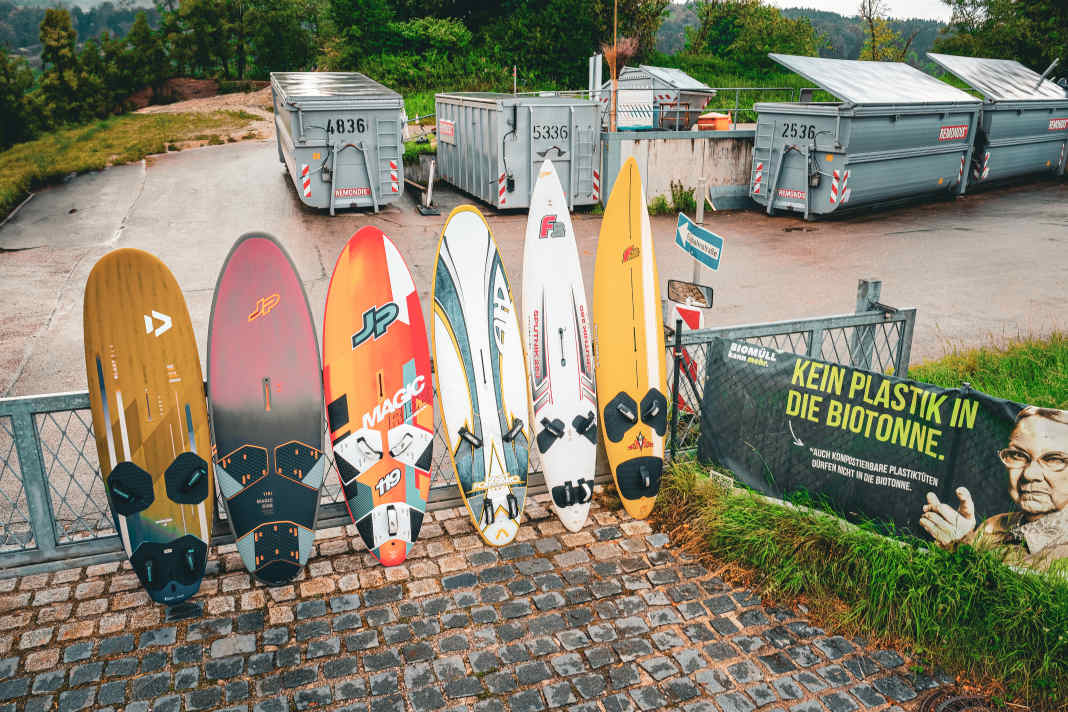





The yellow Ride 282 here is a typical representative from the late 90s, isn't it?
Werner Gnigler: Yes. Speed used to be the big issue. Due to the influence of slalom back then (editor's note: this refers to the racing discipline in the Windsurfing World Cup), the boards have become narrower and narrower. Compared to today, the slalom discipline in the World Cup was only used when there was a lot of wind. And riders like Björn had at least one board for every sail size. That was actually madness. And that's why they could always use the narrowest possible board in the race. And the concept was also transferred to the freeride boards, such as the 60 centimetre narrow Ride 282 here.
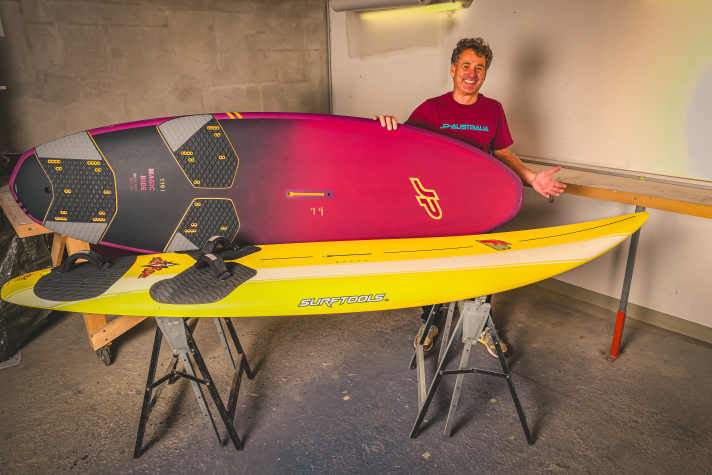
Does that mean that the influence from the racing sector was greater back then than it is today?
Werner GniglerYes. It was only later that the boards became a bit shorter and wider. We had the same problem back then as we do today: planing is the big issue for many hobby windsurfers. And from even further back in the past, the motto back then was "length matters". That was just the way it was in people's heads. That's why length was needed. If you developed very narrow boards and didn't make them long enough, then you had no chance at all of getting going.
Let's take a closer look: I believe that the straight sliding surface is also quite long.
Werner GniglerSo the boards at the time almost all had one metre of gliding surface (editor's note: today 80 centimetres is about standard for freeride boards). Even the Xantos that I built had a gliding surface of between one metre and 1.10 metres. And the nose bend was also insane. They had a scoop of almost 30 centimetres. Now we're at just over 20 centimetres of scoop on the freeride board. So around 10 centimetres less.
Okay. But that could also be better designed over the length with a flat transition, which is what planing is all about.
Werner GniglerYes, and if you cut 40 centimetres off the front here, then we're more or less at the scoop from today. The nose at the front was always out of the water. And if you're not gliding on a narrow board, just standing on it and bobbing, the length also counts for stability. And it's also helpful when tacking. People used to tack a lot more. The mast track was also further forward because the sails had a completely different centre of pressure. That's how it worked back then.
The V is not about the measured value at the edge, but about the angle. (Werner Gnigler)
You can see from the shadow that the Ride actually has a clearer V from front to back than the Magic Ride. Is this also typical of the time?
Werner GniglerYes, the Xantos also had a lot of V. It's not about the V value that you can measure at the edge, but about the angle. If I measure the same value on the edge of a wide board that is 20 cm wider as I do on a much narrower board, then the V-angle is of course much flatter. And the V was already extreme back then. So if you extend the V laterally on the narrow ride, that's twice as much V as today. I now measure over a centimetre at the edge - with such a narrow board.
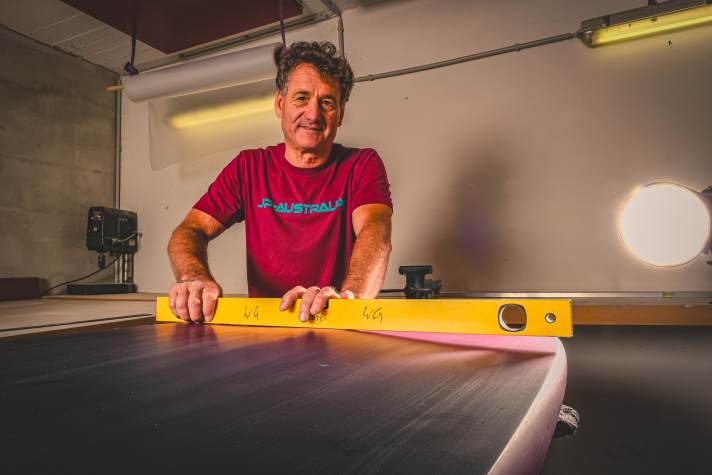
Why is that no longer the case today? Why don't you need the V to the same extent today?
Werner GniglerWe want the boards to have a higher water position. With the V, a board is very cushioned in the water. It doesn't get as free without pressure and doesn't go as fast. It used to be thought that it was necessary for lateral edging, control and comfort. These eternally long boards, if they had been as flat as they are today, would probably have been relatively difficult to ride. Because they lay on the ground much longer and bounce much more. With modern freeride boards, you have the feeling that you're standing right at the back, just riding on the gliding surface. Modern boards also fly relatively freely over the chop. And we use significantly less V in the glide area on the new boards. We already have a V at the front - with roughly the same amount at the edge as back then - but with a flat angle. But at the front, we still want it to dip a little softer. In the planing area, on the other hand, we want the shape to simply generate a lot of lift and bring the board into a free planing position.
Waveboards used to have a lot of V for turning and a lot of rocker in the gliding area, but today there is almost no V at the back, is there?
Yes, because you now incorporate concaves. That comes from surfing. The concaves on a waveboard are about the rail curve. If I have a concave between the foot straps and a little V at the front, then I already have a lot of curve in the rail. But in the centre line it's completely flat, I don't have any rocker at all because I'm only steering it over the rail line. Waveboards all go in that direction with a concave and you control the curve with the depth of the concaves and a bit of V at the front, so you have a completely different curve on the rail than in the centre area.
And it still turns?
Werner GniglerYes, great, because I turn or carve over the edge, not over the centre line of the board. And when I ride straight ahead, I basically have a flat line like a slalom board. But as soon as I edge it up, the curve in the rail takes effect.
The idea used to be that the board could be folded over the V more easily?
Werner Gnigler: Yes, that was the approach, that you can edge it up more easily and of course the rocker so that it turns. But these wave shapes were just brutally slow. And now you can build relatively fast waveboards with the concaves that still turn really well.
The rail shape on the Ride looks pretty beefy, the volume has to fit into the narrow board?
Yes, it was already relatively thick. But if you look at the Sputnik 280, it's even more like a tree trunk. In terms of tucked (editor's note: how far the shape is pulled inwards at the edge, below the widest point towards the gliding surface), we're not that far removed from current shapes. The rails are sharp at the back and a little rounded in the centre. So for a freeride board, it's not that far off. But because the ride is so narrow, it's relatively thick. So it's certainly at least a centimetre thicker than comparable current freeride boards. The rail radius, on the other hand, has only been optimised slightly so that you have a good lift in the turn and it doesn't feel so aggressive. The ride is a little sharper in places on the rail with a little less "tucked" than on the new boards, but not actually that blatant.

What is the "tucked under" responsible for? What does it do?
More "tucked" is more forgiving in the turn, but the board also dips into the water more easily. So if I go into the jibe and don't have enough speed and then have a lot of tuck on the edge, the rail dips into the water and brakes. If I have slightly sharper edges with less "chugging", then I have more surface area when edging up, which results in more lift and gliding through the jibe is easier. However, with the sharper rails I have to be a bit more precise and powerful into the turn. It's always a give and take in development. We have this issue with wave boards, slalom boards, with all boards really: how round or how sharp you make the edges, that's always fine-tuning. This turning point of the edge, for example, the apex point, the widest point, is now slightly higher on the brand new boards. So that the round edge, which is a bit fuller, still remains forgiving and continues to provide lift.
If the apex point is too low, the gliding is over. (Werner Gnigler)
If the apex point is too deep, I have an edge that dives deep into the water, especially when I lose speed and then the planing is over. You can also feel differences when planing. With a low apex point, the water sloshes more easily onto the deck and pushes down. If the apex point is slightly higher, less water hits the deck. These are the little things that make the subtle differences.
This Apex Point, that is the height of the highest width?
The turning point of the radius. This is crucial for all boards. If you have a direct comparison with prototypes, you notice it immediately. The point is a few millimetres higher - and the board just takes off because the water doesn't slosh on it. And also when cornering, sometimes the water really sucks itself up.
Now I can still see the deck shape at the back of the ride in the area of the straps. It just looks beefier to me - if you look at the outside position and compare it with a current Magic Ride.
Werner GniglerYes. You have an outside position and an inside position for the straps. But because the board is so thick, the flow in the shape between the two positions was probably not so easy to create. Now they are trying to harmonise the area so that you can stand comfortably in all footstrap positions. The outside position wasn't too bad on the Ride either. The Ride was a sporty freeride board. You can really step on the gas with your heels. The outside position was just right. But the inside position wasn't very comfortable, of course. That's why we have a much more harmonious deck shape on the Magic Rides, so that you can stand comfortably in the different positions.
What else do we see here?
An extremely narrow stance. Today we have 42 centimetres for freeride boards, back then we had 38. We stood in the straps with a very narrow stance.
What does the wider stance do? What is it good for?
Werner Gnigler: It's easier in the jibe with a wider stance because you're already further forward, with more pressure on the front foot. And you have more control when travelling straight ahead. The aim is to be able to exert even pressure on the board with both legs, then I have control and can accelerate.
I also remember that in earlier tests you often had the feeling that the front foot was pulling out of the strap. That may have been the big fins, but could it also have been the stance?
Werner Gnigler: Yes, I remember that was always the problem. Maybe also because of the length, because you were trying to get the board free. Now the boards are so free on the water that I can exert pressure on the front foot and the board still flies. With these long things, I probably had to pull with my front foot to keep the nose free.
Here we have a Magic Ride of the middle generation, which is even slightly wider than the current one.
surf MagazineEvery trend overshoots the mark at some point. We first had the long, narrow boards and then extremely wide and extremely short boards appeared in the freeride sector.
How long did it take to go from a length of 2.82 metres and a width of 60 centimetres to this? 2.40 metres and 75 centimetres wide?
Werner Gnigler: That doesn't happen overnight. RRD were among the first to be so extremely wide. And then, of course, everyone else discovered the advantages: the wider board is very stable to stand on, it planes relatively early and is very compact. But that was a hype that was a bit overrated. People then realised that such short boards don't glide so well after all. In addition, there was also feedback from the windsurf centres that we might have gone a bit too far after all. So boards were made a little longer and a little narrower again to make the planing phase easier.
There is only a centimetre in width and length between the last and the current Magic Ride 119, but the outline looks completely different.
Werner Gnigler: The relatively narrow tail was a problem. We came from very narrow boards. Then the boards got wider in the centre and the tail didn't grow proportionally. That was okay for initiating the jibe, but it's a problem for planing through. If the board is so extremely wide in the centre and relatively narrow in the tail, it's difficult to keep your balance in the turn. If it's a bit more balanced - tail width and centre width - then it's much easier to carry the speed through.
I remember boards in the test that turned super tight even though they were so wide. But you had no chance of riding a carving jibe on them.
It then sinks in the tail. Or it stands up in the jibe because you have so much curve. The board is edged on the rail in the jibe.
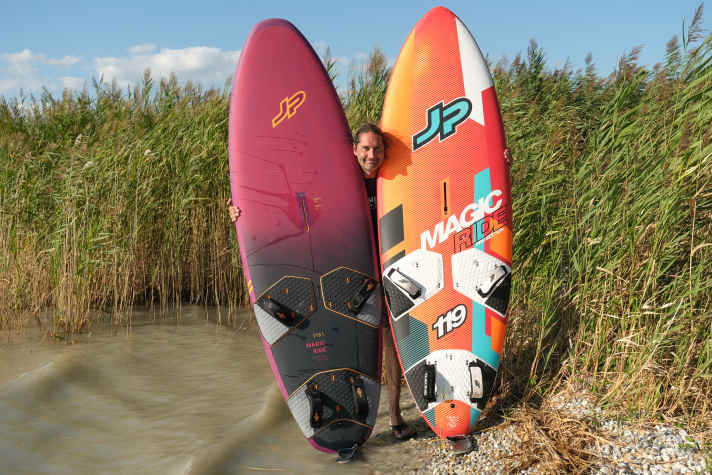
But then we've probably reached the ideal dimensions for freeride boards? There shouldn't really be that much change, should there?
Werner GniglerYes, we have a very high standard. But we also have a lot of different models. We have three freeride boards: the Super Ride, the Magic Ride and the Super Sport, which are tuned a little differently depending on the area of use. The question remains: what is the ideal freeride board? For the less experienced it is one model and for the more advanced the other models. That's why you can't say we have the ultimate for all time. But for the Magic Ride target group, I think we have a very good balance. We are always working a little further for the future. That's fine-tuning now. These are no longer such huge steps.
Do you think that the older Magic 119 from 2016 can do anything better than the current one?
Werner GniglerThe radical, narrow jibe perhaps. Because it has the narrow tail - I can really get into it and then - bang - it goes round the corner. But I think the current board is much easier in terms of balance when planing. It's a bit wider at the front, I also have more volume at the back, more surface area and a slightly straighter outline. In terms of speed, I can also push more because I can exert a lot more pressure with my back foot thanks to the wider tail. On a narrow tail, you often stand a bit crooked on it, so you can never accelerate like that from the position alone. But that doesn't make the last model a bad board. If you were to buy it today, you'd get a good board that you'd have fun with.
What has changed with the fins?
Werner Gnigler: The boards had very large fins for their narrow tail in the 90s. With such a narrow tail, you shouldn't be riding monster fins. You don't have the leverage. It's also an evolution that you can now ride larger fins in freeriders thanks to the wider tail. This means you have more leverage and can convert this fin surface area into power. You break your feet on that thing (Werner points to the old Ride) if you have such huge fins in it.
Could it be that you used to have to work a lot more against the fin with your front foot due to the capsize moment?
Werner GniglerWe now have relatively little V in the planing surface, which naturally makes the board much more solid on the water. The width in the tail gives me a stable counter-pressure. With the narrow things - it's like a tree trunk - they always roll back and forth. That's probably why it was so strenuous to ride.
You hear - less often, but still from time to time - that such wide boards should be more difficult to control than narrow ones.
Werner GniglerNarrow boards are theoretically easier to ride on Chop. But you mustn't forget that the old generations were extremely long. And the length offers a lot of contact surface, which is why they become so uncontrollable. The wide boards have a relatively low nose, less contact surface and the surface area I have is used effectively.
And there is not so much board length on the water?
Werner GniglerExactly, the flat section is only about 80 cm and then you try to create a harmonious bend in the centre area so that you can easily overcome the sliding threshold.
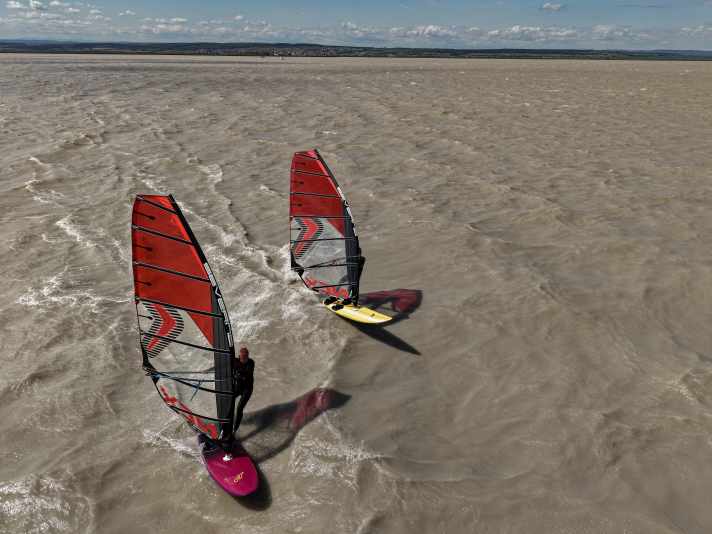
The high planing position is due to the flat underwater hull and the buoyancy?
Werner Gnigler: Due to the flat underwater hull and the more effective fins and sails. You always have to look at the whole package. A better fin has taken us further with the boards, a better sail has taken us further and vice versa. You can't always see it in isolation, that we board designers have been so clever and have developed further, but it has always given us an impetus, which came from the fin and the rig.
You said that a lot of the influence used to come from World Cup racing. Do you still take things from the World Cup today or is the development of freeride boards completely separate?
Werner GniglerWe learn even more, because in the World Cup you also have to sail standard boards. Dunki had at least one board for every sail size. That would be unimaginable today. Financially and in terms of handling, it's no longer possible. And the World Cup riders - if you look at what speed they are travelling at and in what conditions - they have the same problem as every recreational surfer: a control problem. And that's why so much of the V-curve, the scoop and the rocker lines come from racing. Racing helps us a lot because the guys are all very experienced.
There was once a phase in which triple concave underwater hulls with a funnel-shaped concave in the centre were used. This has apparently not caught on.
Werner GniglerYes, that used to be the case, it increased the surface area. That was the basic idea. But a flat surface has the most buoyancy when it hits the water. So with a lot of V - when it hits - it opens up the water surface a little and the board dips slightly and brakes a little. And then at some point these completely flat slalom boards came from River Gorge.
But they were hardly rideable.
Werner Gnigler: Yes! But really fast. And because they were completely flat, they had a great response. So you hit the water and always stay on top. You also have less wetted surface area. Concaves increase the wetted surface, which is slower. But I want to reduce the surface area. That's why we now have the cut-outs in the tail. These huge concaves also slow you down at some point. At the actually slow speed of a windsurfer, it's not as if I create a cushion of air under the board that lifts me up.
That's right. Air is not blown in at 200 km/h.
Werner GniglerBut that was just the theory. There was a lot of trial and error, as in any sport.
So it's not about the airflow under the board? It's about the touchdown on the water?
Werner GniglerExactly. And also when planing. As soon as I have a bit of speed, a flat surface also generates lift. And that's what it's all about. We have to overcome the planing threshold as quickly as possible. And that's why simpler, flat underwater hull concepts have prevailed. Light double concaves with a V are still used in the front area to dampen the impact on the wave a little, especially with freeride boards. This is much less the case with racing boards.
We have now reached a level of performance in freeride boards where the top speed that good hobby surfers ride hardly changes.
Werner GniglerTop speed is always an issue, but I think the decisive factor for the customer is the average speed. And how comfortable, how easy and how relaxed I can surf fast across the lake. To achieve top speed, I have to ride a deep space sheet course and there's not much difference between the last generations of boards, it's all about riding ability. But there is a huge difference - we notice this during our comparison rides - if the new board is a bit better, I can ride past my test partner in a very relaxed manner. That's the progress for me: that I ride faster on average, across the lake. But above all, it's about the overall package: I'm more comfortable on it, the balance is right, I can keep the sail tight and relaxed and then I'm simply a bit faster.
So if you have a ten-year-old board, like this one for example, and you buy the new one, you can't think you're going 5 km/h faster?
Werner Gnigler: Not at top speed, because I only reach top speed when I'm riding deep space wind courses. But when I'm surfing across Lake Garda, I can easily gain a lead of 50 to 100 metres.
Freeriding is also about other things. How easily and well you can get through the jibe, for example.
Werner GniglerYes, it's about the overall package. Everyone wants to be fast, of course. But gliding through the jibes - that's the goal. Your surveys show that: Topic number one is planing, then learning to jibe. A modern board makes this much easier and quicker compared to older material. You notice the differences immediately. I'm sure you'll feel it immediately, especially on Lake Neusiedl.
Everyone wants to be fast, but it's all about having fun on the water! (Werner Gnigler)
Is it always just about new shapes?
Werner GniglerNo, of course also the equipment, for example. The boards used to have no foot pads at all, then only very thin ones. Then we used to have pads that were thicker under the heel. That was counterproductive: I shape a good, ergonomic deck shape and then the pad is reinforced on the wrong side. Now they are evenly thicker and more comfortable. It's always fine-tuning: making everything a little better. Just like a car - when you get into a new car, you think "Wow!" Everything seems a bit better, a bit nicer, the driving experience is just great. But you drive just as fast as in the old car. But nowhere near as comfortable and the driving pleasure and comfort are much greater nowadays. Windsurfing is a fun sport and has to give you a great feeling when you're on the water. That's why we also try to improve the little things in the package for what windsurfing is all about: having fun on the water!
Werner, thank you for the interview!

